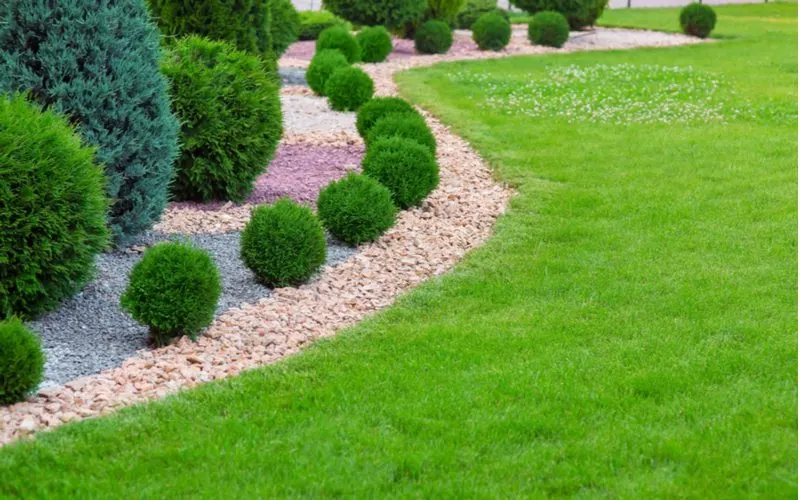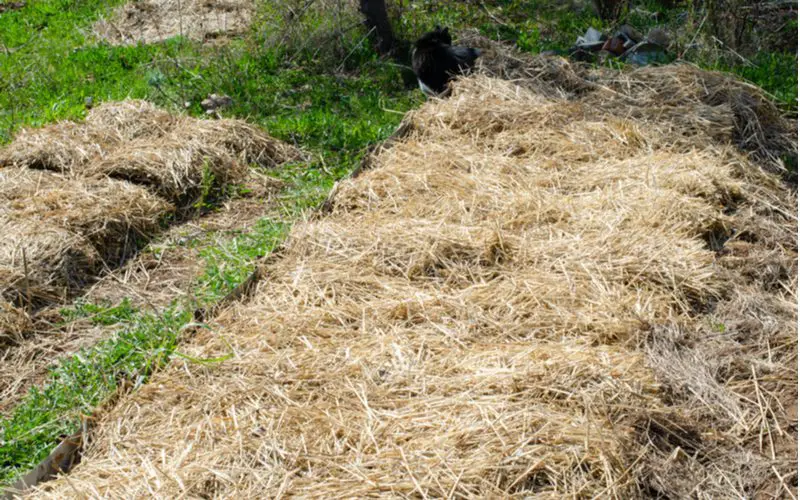Mulch alternatives come in all shapes and sizes. You can use rocks, eggshells, recycled tires, cocoa beans, and much more.
But which is best? Don’t worry—you’re in the right place. Read on to learn more.
What Is Mulch?

Felipe Sanchez/Shutterstock
Ah, mulch, truly the gardener’s best friend!
Even if you’re not a gardener or a landscaper, you’re no doubt still familiar with the classic practice of layering wood chips around gardens, outside businesses, along walkways, on playgrounds, and in many other places.
The most common type of mulch is made of wood. While it’s the most popular, there are plenty of people who aren’t too fond of wood mulch. Say you’re not a fan of wood mulch, for whatever reason.
You might be wondering, “What kind of mulch alternatives can I use instead?” If this describes you, you’re in luck. Below, we’ll cover a comprehensive list of all the best mulch alternatives, some of which are super cheap or even free!
Mulch simply refers to a material that is layered on top of the surface of the soil. If you look up the definition, it’s described as:
“A protective covering (as of sawdust, compost, or paper) spread or left on the ground to reduce evaporation, maintain even soil temperature, prevent erosion, control weeds, enrich the soil, or keep fruit (such as strawberries) clean.”
Since your typical wood mulch is only one of many types, you can rest easy knowing you can find plenty of mulch alternatives to suit your needs.
9 Handy Wood Mulch Alternatives
1. Rock Mulch

Bespaliy/Shutterstock
Rock mulch also helps suppress weed growth and retain moisture. Rock mulch is less expensive and rarely needs replacing. It’s aesthetically pleasing for minimalist landscaping design.
In colder climate regions, rock mulch helps retain heat and could extend the growing season of your plants. It’s an inorganic wood mulch alternative, however, and doesn’t provide any nutrients for the soil.
2. Crushed Shell Mulch

Jimj0will/Shutterstock
It’s aesthetically pleasing for more delicate landscaping designs. Shell mulch tends to decay slower and also adds calcium to your soil. To avoid over calcifying the soil, you can put plastic sheeting under your seashell mulch.
If you live in a coastal area, these shells are a free option as a mulch alternative. Simply collect enough shells, rinse salt deposits from their surfaces, crush them, and use them to spruce up your front of house landscaping.
3. Cocoa Bean Mulch

Charlotte Bleijenberg/Shutterstock
It’s a unique, creative wood mulch substitute. Cocoa shell mulch is an excellent substitute for wood mulch as it retains moisture, regulates temperature, and helps with weed control.
Additionally, cocoa mulch adds a pleasing scent of coffee to your garden. Be careful, though, as cocoa shell mulch can potentially be harmful to pets and other animals. It’s also relatively expensive.
4. Straw Mulch

Lake_Wright671/Shutterstock
When you’re looking for an economical solution to mulching a large area of land, hay or straw is your go-to mulch alternative.
Straw is a great secret weapon for those who want to mulch near their vegetable patches. Straw or hay provides a lot of nutrients, which help the vegetables survive and thrive.
5. Cardboard

Sam Barrett/Shutterstock
Since cardboard is organic, you can use it as a good alternative to wood mulch and other organic mulches. You only have to shred the cardboard in order to use it as cheap, effective mulch.
It also decomposes, providing nutrients for your soil and plants. Although it’s a great mulch alternative, cardboard can easily blow away. Prevent this by using it as a base layer under heavier mulch alternatives like rock.
You can also mix cardboard with existing wood mulch to make your wood mulch stretch further. Also, keep in mind that some cardboard is treated with chemicals that can harm your soil and your plants.
6. Rubber Mulch

Melissa Tate/Shutterstock
Rubber mulch comes from 100% recycled rubber, mostly from old car tires. Rubber mulch is more sustainable than wood mulch and reuses materials that would otherwise be disposed of in a landfill.
Rubber mulch lasts significantly longer than wood, which makes it a great mulch alternative.
Due to rubber’s non-porous composition, all moisture is directly delivered to the plants and not absorbed by the mulch alternative. Rubber mulch is one of the best weed barriers out there. Also guards against the growth of fungi.
7. Leaves

Rahmaniyas/Shutterstock
If you’ve got to rake bags of leaves every autumn, then you’ve got a free mulch alternative every year! Dead leaves serve to form a barrier over the soil and retain moisture. This will also guard plant roots against the threat of frost.
While you can just use the leaves as you find them, they are less likely to blow away when you shred them first. To shred your leaves, you can just run your lawnmower over them and then layer the shredded leaves wherever you’d like.
8. Pine Needles/Pine Cones

Kroshanosha/Shutterstock
You can use a layer of pine needles as a cheap, effective mulch alternative. Feel free to use either fresh pine needles or dried ones. Using a 1 to 2-inch layer of needles will protect your plants from frost as well as prevent the soil from getting too hot.
If your soil is too alkaline, you can add acidic pine needles to counteract it. On the other hand, pine cones are also an excellent choice, and where there are pine needles, there are usually pine cones.
Since pine cones boast resin, they are water-resistant, like rubber mulch, and allow for better moisture delivery and dispersion.
This trick even helps to prevent soil erosion, as do whole pinecones, by circulating the air. You can also shred the pine cones for a different aesthetic.
9. Grass Clippings

Kuznetsov Dmitriy/Shutterstock
If you have to mow your lawn, you can find an almost infinite amount of free wood mulch alternatives in your bag of grass clippings. Normal grass is positively chock-full of nutrients for your plants.
And you can use grass-clipping mulch anywhere on your property without fear. It’s best to let your grass clippings dry out first before use, as it prevents overheating and quick decomposition.
Frequently Asked Questions
There are lots of things to consider when you undertake a landscaping job like this, especially if you’re deviating from the status quo.
Read below to learn the answers to a handful of questions that other people ask about wood mulch substitutes.
What Are the Benefits of Using Mulch?
- Mulch is a great landscaping tool as it improves the quality of your soil.
- It helps to better aerate the soil and allows for more even moisture distribution.
- It's highly nutritious, allows it to hold water better, and also helps to break up clay and other sediments.
- A layer of mulch acts as an effective method of insulation, keeping the soil cooler in even the most unforgiving summer heat.
- Mulch also helps to stop pesky weeds right in their tracks. The weeds that do make it are easier to remove.
What Are the Downsides to Using Wood Mulch?
Some wood-based mulches might leech vital nutrients from your plants, most notably nitrogen. Though you can counteract this by adding fertilizer to the mulch, though that adds more work and more cost to your landscaping ventures.
Wood mulch is also very efficient at suppressing seed germination. This fact and the coarse texture of wood-based mulch make it less than ideal to place around flower beds or vegetable plots. Wood mulch is very common but can also be very pricey if you're buying quality products.
A single truckload of mulch costs $550 and will cover 20 cubic yards. This is not even including a delivery fee, which generally starts at $160. You'll also need to replace the mulch every 1 to 4 years, depending on the type of wood mulch you choose and how much traffic the mulched area experiences.
Not to mention wood mulch is a veritable paradise for common pests like slugs and termites. This can lead to some truly nightmarish landscaping catastrophes! Then there's the fact that wood mulch is so common, you might find it aesthetically boring.
Seeing as there are loads of different mulch alternatives, you might want to give your yard or property a little bit of originality in design and find a substitute for wood mulch.
How Much Mulch Alternative Should I Buy?
Like wood mulches, most mulch alternatives you purchase are available by the bag or in bulk order. Bulk order mulch is measured in cubic yards. If you're trying to calculate the volume of bulk order mulch you need, you want to start by multiplying the area in square feet by the depth.
Be sure to use the fraction of feet and not inches when finding the depth. Once you've found this answer, you'll need to divide by 27 so you can figure out how many cubic yards of mulch alternative you need. Then you can go about buying your new mulch alternative.
How Do I Apply Mulch Alternatives?
Before you layer your mulch alternative, you should water your yard or property and make sure it's clear of all weeds. Doing this will improve the efficacy of your mulching efforts and save you time later on.
You'll want to replace the grass growing under any trees with mulch as this helps to ease competition for water and nutrients for the tree. This kind of mulching mirrors how trees naturally grow in the wild. Remember to keep mulch 6-12 inches from the base of the tree or any shrubbery.
This will help to keep rodents from burrowing into your mulch substitute and turning your mulch alternative into a new home. Lay down 2-4 inches of mulch in your chosen areas.
With finer-textured mulches, mulch that is a half-inch or less should not exceed a 2-inch depth. If you're using a coarser mulch, stick to a 4-inch depth. Courser mulches and thicker mulch alternatives can be applied 4 inches deep.
Closing Thoughts on Mulch Alternatives

Clarke Colin/Shutterstock
We know that mulch has some great benefits, that wood is the most common type of mulch, and that wood specifically has quite a few disheartening drawbacks for a would-be gardener.
Luckily, though, there are several different mulch alternatives you can easily swap out to get the most out of your property; just do a little searching, and you’ll find a substitute for wood mulch in no time!

